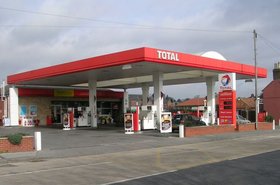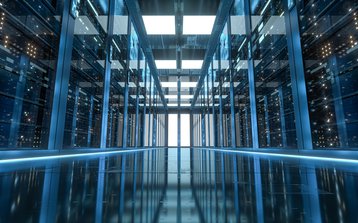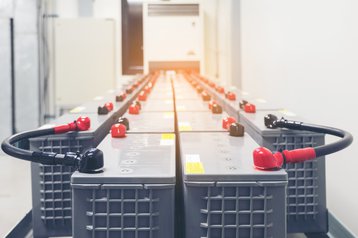According to Juniper Research, the number of Internet of Things (IoT) devices in 2021 reached 46 billion, a 200 percent increase compared to 2016. These devices produce an enormous amount of data that needs to be stored – often remotely in the cloud – then processed and analyzed.
The cloud has revolutionized the way we store information. It offers a cost-effective and scalable platform for storing data, processing transactions, and running applications.
But if the data can be accessed from anywhere, it needs to be physically located somewhere, often even distributed across multiple locations, in data centers.
Data centers are the brick and mortar of digital infrastructures. Their strategic importance has risen these last few years, along with our dependency on data.
Data needs to be available, quickly. Data is time. Data is money. Data is security. This places extra demands for reliable, always-on data centers.
Saft batteries can provide the power backup data centers need to operate at optimal capacity without outages. This is how Saft is powering the IoT all along its value chain, making sure the data is effectively captured by sensors, then stored securely to be available whatever happens.
Diving into data center trends
Our economy is increasingly relying on data centers, which drives market growth and innovation.
The increasing adoption of digitalization, the pandemic, rising investments from telecommunication and service providers, and government initiatives towards the digital economy are significant factors for data center market growth. These last two years, the number of data centers available has grown massively.
Microsoft, Amazon (AWS), Google, and Apple are investing billions of dollars in the market and rapidly developing their own infrastructure. In addition, as many thousands of companies, they loan hosting space to colocation companies to house their critical applications and data, along with a number of cloud services.
Their goal? To provide maximum uptime, optimized redundancy, latency, and security.
Most of the time, you don’t know where your data is stored. It can be anywhere, often copied for latency purposes – stored closer, the data can be accessed quicker.
Data centers must realize unprecedented performance to align with modern business requirements. To achieve these goals, data center providers spend a lot of time and money improving the overall efficiency of their infrastructure.
Edge, colocation, modularity, scalability, hyperscale are just a few trends shaping the market.
Hyperscale of data centers, new challenges for energy efficiency
Hyperscale is all about achieving massive scale in computing. Colocation and cloud providers are building data centers designed for scalability.
This allows them to achieve higher levels of performance, uptime, throughput, reliability, and redundancy, whilst making better use of the equipment and economizing on scale.
These data centers can be the size of several football fields and host thousands of servers running 24x7, with the optimized operation needed to oversee the day-to-day running.
Hyperscale data centers are power-hungry, they need a lot of electricity to run their equipment and keep the machines cool. So much, that in some areas it is putting the grid under constraints with potential restrictions, as recently in Ireland or in the Netherlands.
Imagine: just one (large) data center can consume up to 120 MW and there are thousands around the world. It is estimated that data centers are using around 200-250 TWh each year, more than the UK’s annual energy consumption and around two percent of worldwide greenhouse gas emissions.
This evolution in power supply and demand leads to a number of critical challenges that need to be addressed.
Reliability matters
The accessibility of the system can be crucial. Most of today’s applications, from business, to transport, to finance, education or security systems are running on the cloud.
The true cost of data loss extends far beyond what we think. Data loss can cause security or safety issues and loss of revenues. It can also easily tarnish a company’s reputation.
According to a study by Gartner, the average cost of unplanned downtime was $5,600 per minute in 2014.
Since then, the downtime cost has continuously increased. Based on the last survey report from Uptime Institute, six power outages over 10 in 2021 had a cost above $100,000 USD. This augmentation is driven by the increased value of the business operations being supported by data centers.
Downtime is therefore not an option. To ensure that data centers offer continuity in operations, a reliable power supply and backup are crucial.
Most data centers feature a two-ends power supply redundancy, capable of taking over from each other if one is down.
For the power supply, it implies a connection to the main grid, and for the power backup an uninterruptable power supply (UPS) capable of providing short-term power and ensuring seamless operation when the input power source fails, until the backup generator is operating.
Battery systems have become central to the economy today as they help guarantee the availability of the data that keeps businesses, transport, finance, education and security systems running.
Energy efficiency and carbon footprint matter
Data centers are growing, and their use of electricity goes against the current trend. Whereas other industries are aiming at consuming less and less energy, despite significant and relevant effort to be energy efficient, overall, data centers keep on using more.
Energy represents roughly 40 percent of data center’s operating costs. A significant part doesn’t go on powering the servers; instead, it’s needed for cooling the data centers equipment and servers.
Optimizing the energy efficiency of the power systems in place, as well as reducing their carbon footprint is therefore becoming key to data center operators who are increasingly focusing on these challenges.
To that end, many innovations are seeing the light of day: free river cooling systems, liquid and free cooling, harvesting technologies, etc.
These last few years, Lithium-ion (Li-ion) batteries, and more particularly Saft Flex’ion battery systems, have widely contributed to this objective.
Li-ion batteries offer high power density – up to six times more than lead acid batteries – to reduce the overall infrastructure footprint, a long lifespan (around 20 years) and minimal maintenance to reduce risk and operation cost.
Operational at high temperatures (up to 35°C under UL9540A requirements) they offer energy and water consumption savings by downsizing and reducing the consumption of the HVAC (air conditioning). They also offer faster recharge times to recover quicker.
Saft is permanently striving to reduce the carbon footprint of its range of products. We have adopted a lifecycle approach to do so, giving priority to recycled raw materials over virgin raw materials, reducing our plants’ air and water releases year after year, minimizing water usage, reducing fossil energy consumption and associated CO2 emissions, and ensuring that our customers have recycling solutions for their spent batteries.
Time and location matter
The location of the data center is more than just a mere consideration of cost per square meter, other rules are governing it as well.
Data centers are essential to the treatment of day-to-day company data. Other trends like big data, AI, IoT, smart cities, autonomous vehicles, health and virtualization applications are calling for a more decentralized way to treat and manage data, at the Edge of the network. Does this term ring a bell to you?
Just as Edge computing in IoT involves treating the data at the sensor level, Edge computing also applies to data centers.
Smaller, localized data centers are created to treat the information closer to the source, reducing the necessary data travel time between the devices that capture it and the data center that treats it, improving the latency and the security.
The infrastructure – the availability of the fiber on location for example – can play a role too. France is for that purpose, one the biggest hubs in Europe.
Another rule governing the choice of location is local regulations. Indeed, there are more and more data regulations based on sovereignty, cybersecurity, and personal data protection – like GDPR – that may impact the use of data and impose limits on the transfer and sharing of such data, and consequently, on the data location.
Hyperscale data centers and Edge Computing data centers have thus become two complementary parts of the data center operator’s offer, but in both cases, the use of a compact and lightweight Li-ion battery for UPS is key in order to make the most of the available floor space, as well as the load-bearing capability of the floors.
Safety on top
Another trend is shaping the future of data centers: operational safety. They are the guardians of companies’ strategic data and, since they operate within buildings, with people around, safety is paramount.
Operators are looking at mitigating the risks by choosing secure solutions. Choosing Flex’ion is the insurance of having the optimum balance between the highest level of safety, power density and calendar life.
Lithium Iron Phosphate has a long-proven track record of safety. Our Flex’ion range of products complies with IEC 62485-2, UL9540A and UL1973 safety standards which are incredibly hard to obtain.
Now you know more about the data center challenges: reliability, performance, safety, efficiency, and low carbon footprint. With Saft batteries taking it all into account, you have the insurance that your data is protected, from collection, processing to storage.
For more information on our product range designed to power data centers, please visit the dedicated product page.
More from Saft
-

Data center UPS: how to make Li-ion the safe choice
Operators still shy away from Li-ion batteries due to safety fears - but they can be made profitable and safe when you make the right choices
-

Microsoft and Total partner, explore using large batteries instead of diesel genset
Plus Total will use Azure and Microsoft 365
-

Safety Aspects of Li-Ion Batteries Used in Mission-Critical UPS Batteries for Data Centers
Download this free whitepaper from Saft.



